In today’s fast-paced healthcare environment, information is abundant—but often inaccessible. Over 80% of healthcare data is unstructured, buried in free-text clinical notes, imaging reports, and discharge summaries. This makes it difficult to access, analyze, and act on valuable insights.
But artificial intelligence (AI) is rapidly changing that.
By leveraging AI, healthcare providers can transform disorganized data into structured, searchable, and actionable formats—paving the way for smarter decision-making and improved patient outcomes.
This article explores the role of AI in structuring medical data, its real-world applications, and the transformative benefits it brings to clinical practice.
Understanding Unstructured Medical Data
Unstructured data includes any information that doesn’t follow a predefined format. In healthcare, this typically means
- Free-text clinical notes
- Voice dictations
- Radiology and pathology reports
- Scanned documents and PDFs
While rich in detail, this type of data can’t be easily interpreted by traditional software or analytics tools. It becomes a roadblock for everything from clinical decision support to population health management.
According to Arcadia, approximately 47% of data is underutilized in healthcare decision-making, highlighting the challenges posed by unstructured data.
Why Structuring Medical Data Matters

Unstructured data isn’t just inconvenient—it’s a clinical risk.
Without structured information, healthcare professionals may:
- Miss critical details in a patient’s history
- Encounter delays in diagnosis and treatment
- Struggle with incomplete or inconsistent documentation
Structured data, on the other hand, allows for:
- Faster information retrieval
- Easier integration with decision support systems
- More accurate billing and compliance reporting
Think of it as turning a messy filing cabinet into a streamlined, searchable database.
How AI Structures Medical Data

AI—specifically Natural Language Processing (NLP) and machine learning (ML) tools designed to understand and structure human language.
Here’s how it works:
- Text Recognition— AI reads free-text clinical notes and transcriptions.
- Entity Extraction— It identifies relevant terms: medications, symptoms, diagnoses, and procedures.
- Integration— Structured data is automatically inserted into the correct EHR fields.
Modern tools like Amazon Comprehend Medical, Microsoft Dragon Copilot, and Merative L.P (formerly known as IBM Watson Health) can extract meaningful insights in seconds—saving time and reducing human error.
Key Benefits of AI-Powered Data Structuring
AI doesn’t just tidy up data—it transforms workflows. Here are the top advantages:
- Faster documentation: Clinicians spend less time typing and more time with patients.
- Reduced administrative burden: Say goodbye to after-hours charting.
- Improved analytics: Structured data supports clinical insights and predictive modeling.
- Better diagnosis and care: Access to full patient context improves clinical decisions.
- 🔐 Regulatory readiness: Easier compliance with HIPAA and audit standards.
A study published in JAMA Network Open found that AI-powered clinical documentation improved clinicians’ electronic health record experience, suggesting a potential reduction in burnout.
Real-World Applications in North American Healthcare
Across the U.S. and Canada, major healthcare systems are already adopting AI for unstructured data management.
- Emergency departments use AI scribes to capture notes during high-volume patient visits.
- Telehealth platforms embed AI to auto-structure virtual visit transcripts.
For example, Mayo Clinic implemented AI-assisted documentation that cut provider documentation time by up to 70%, allowing more focus on patient care.
Addressing Concerns: Accuracy, Bias & Privacy
As with any technology, responsible AI use is critical. Common concerns include:
- Accuracy: AI models must be continuously trained and validated to avoid misinterpretation.
- Bias: Tools should be tested across diverse populations to ensure equity. Research shows that AI models can perpetuate healthcare disparities if not properly managed.
- Privacy: All AI tools must meet HIPAA standards and safeguard sensitive health data, as integrating AI into healthcare necessitates updating HIPAA security measures to address new challenges.
The Future is Intelligently Structured
AI is revolutionizing how we handle medical data—not by replacing clinicians, but by empowering them. Structuring data unlocks critical insights, streamlines workflows, and enhances patient outcomes.
As AI adoption grows, the opportunity to reduce burnout, improve diagnostics, and accelerate innovation has never been greater.
Ready to embrace the future of intelligent healthcare? Discover how Dorascribe AI can help structure your data—one note at a time.




